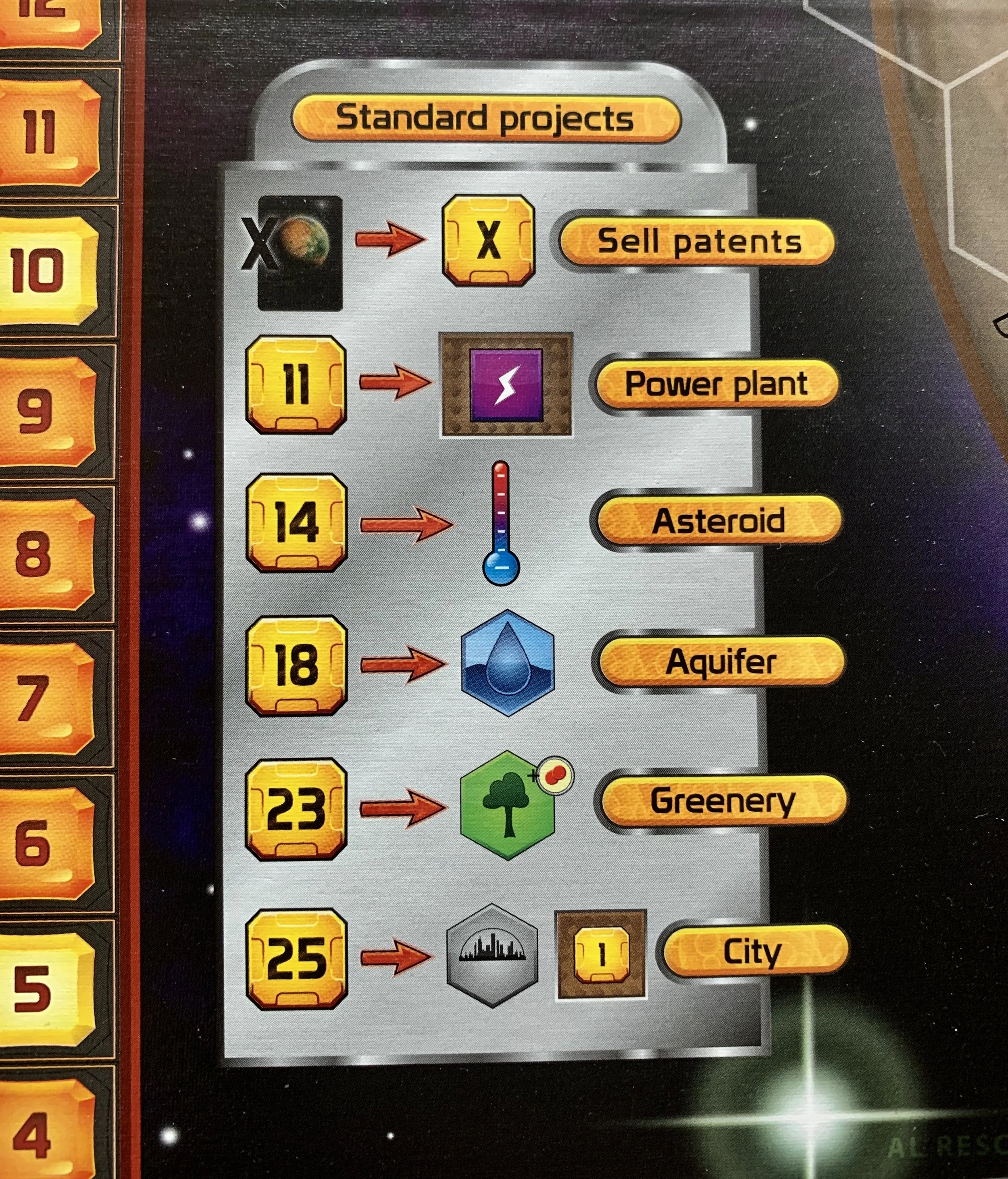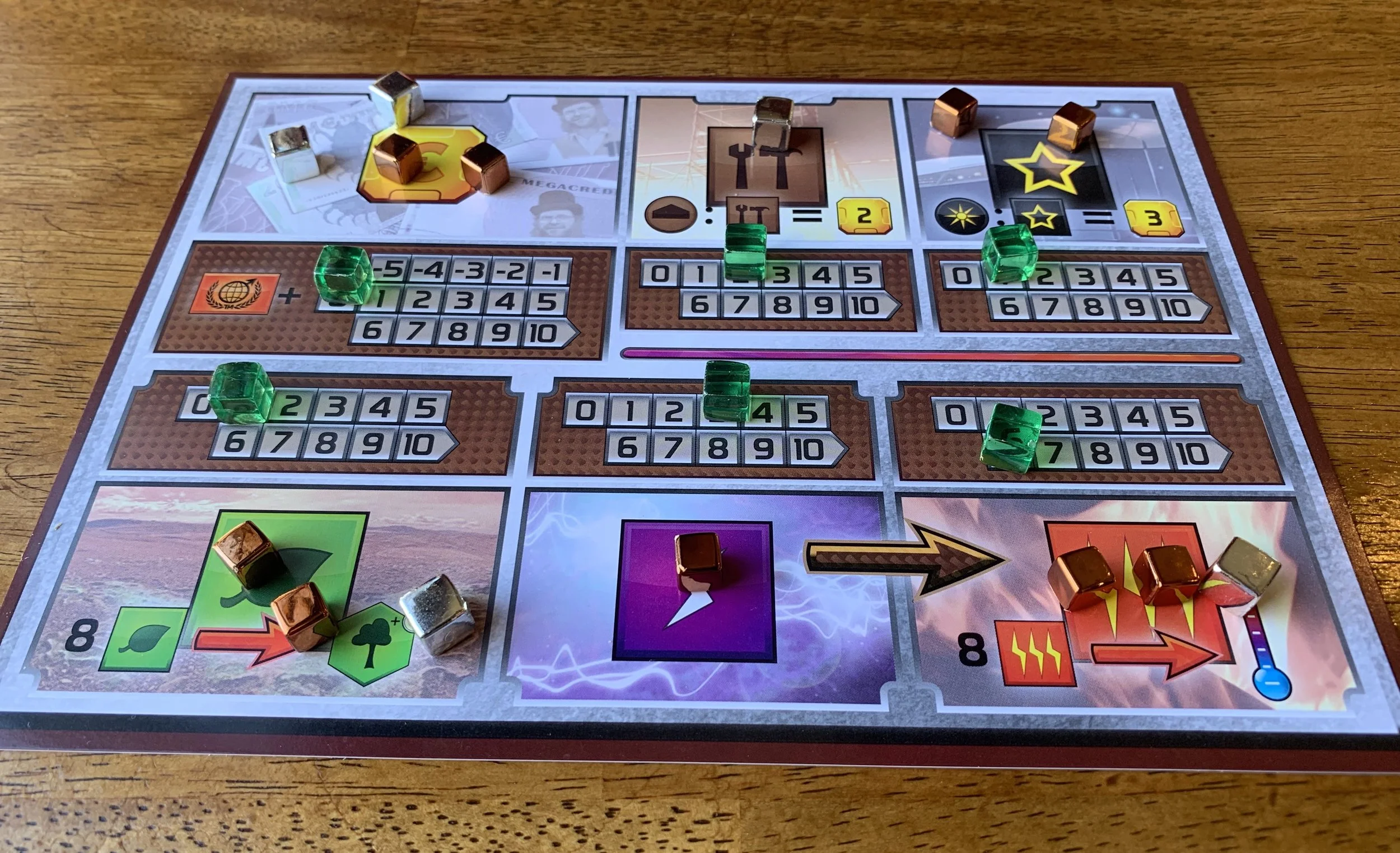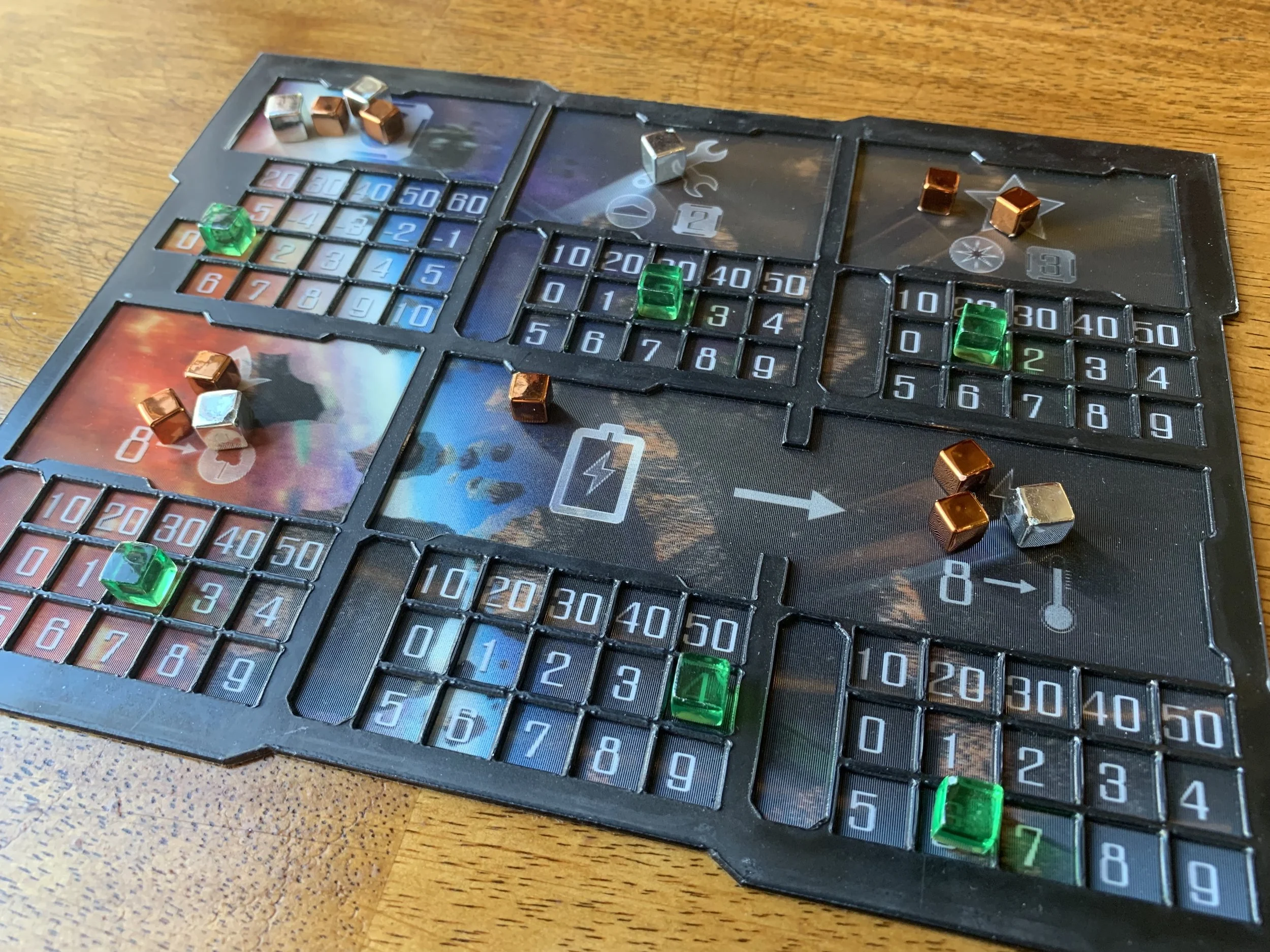Is There Life On...? A Single-Take Review of Terraforming Mars
/The time has come for us to leave the bounds of planet Earth and reach for the stars in search of a new home. But where can humans go in our solar system? At this point, only to our red neighbor, Mars. But that harsh planet isn’t ready for us to live on its surface, so we have no choice but to terraform it. Today’s review puts you in the boots of those first, visionary people: Terraforming Mars, by Stronghold Games and designer Jacob Fryxelius. So is Terraforming Mars a place to call home, or is it just a red menace? Let’s find out!
The Components
Resource cubes
1 Game board
5 utterly garbage Player boards
17 Corporation cards
208 Project cards
8 Reference cards
200 Player markers (in five colors)
200 Resource markers (in three different sizes and colors that correspond to their value: gold, silver, and copper)
3 Game board markers
9 Ocean tiles
60 double-sided Greenery/City tiles
11 Special tiles
1 First Player marker
The Overview
Players are Corporations, each with its own strengths, vying to be the best at terraforming our red neighbor. You’ll buy and play Projects to contribute to that end, building up your Terraform Rating, which translates to money during the game, and VPs at the end of the game. There are three Global Parameters that get increased throughout the game: temperature, oxygen, and oceans. When all three are at their max (after many generations), the game is over.
The Setup
Corporations!
Before you set things up, you’ll have a few decisions to make. There’s a basic setup, which is actually a great way to play it the first time, just to get things down. But I’m going to do setup and gameplay for players who aren’t new, because it’s how you’ll play 99% of your games.
Set out the board and have each player take one of their Player markers and place it on space 20 of the Terraform Rating (TR) track around the edge. This represents your basic income at the start of the game.
Place one of the big, white Game Board markers on space 1 of the TR track, space 0 of the Oxygen track, and at the bottom (-30 C) of the Temperature track. Also place the nine Ocean tiles onto their space of the board.
Each player takes his or her colors of Player markers and places one on the 1 space of each of the six resources on the Player boards.
Then each player is dealt two Corporations, and 10 Project cards. You’re able to fully look at all of these, and the synergies that might be there, while making your decision about which Corporation to choose, and which Project cards to eventually purchase.
Players choose their Corporation, and then decide which of those 10 Project cards they’ll keep. For each card they keep, players must pay $3. Any unwanted cards are discarded into a facedown discard pile.
The Gameplay
Terraforming Mars is played in a series of Generations, each of which has four phases:
Player Order phase—The First Player marker is moved one player clockwise, and the Generation marker is moved up one step on the TR track. (You skip this during the first Generation.)
Research Phase—This is another decision point for players. In the regular game, each player draws 4 cards and then decides which to keep and pay $3 for. One of the variations on this is to draft cards, which I much prefer. You draft cards to your hand, and then decide which to keep and pay $3 for. So you can “hate draft” cards just to keep them away from an opponent, and then choose not to buy them.
Action phase—Players will take one or two actions, or pass.
Play a card from your hand.
Use a Standard Project.
Claim a Milestone.
Fund an Award.
Use the Action on a blue card.
Convert 8 Plants into a Greenery tile.
Convert 8 Heat into a Temperature increase.
We’ll explain each of these a little later.
Once you pass, you’re out for the rest of the Generation, and when everyone has passed, the phase ends.
Production phase—Each player does this simultaneously. First you turn any Energy into Heat, and then you go through each resource and generate resources based on where your marker is.
All of those phases are clear, other than the Action one, so let’s dive into that and look at those Actions in detail.
Each player can take one or two Actions on his turn, and you can do the same Action twice in one turn. If an Action causes you to increase the Temperature or Oxygen, or place an Ocean, you increase your TR for each step of increase.
The different types of cards
Play a card from your hand.
Some cards have a requirement in order to play them. It might be that the Temperature or Oxygen has to be at a minimum (or maximum) level. Or perhaps there have to be two Ocean tiles on Mars. Or you might have to have Titanium production.
If you meet the requirement (if any), then you have to pay the cost of the card. You’ve already paid $3 to keep it in your hand, and now you pay the cost in the upper left of the card. You might have ways of lowering that cost. For example, you can use Steel to pay for cards with the Building tag—each Steel reduces the cost by $2. Titanium reduces the cost of cards with the Space tag by $3.
Then you place it down, depending on the type of card it is.
Red Events are one-time cards that trigger and then are placed facedown in a personal pile; they might be worth end-game points.
Green Automated cards trigger and then are placed faceup with only their tags showing.
Blue Active cards have ongoing effects, so they’re played faceup and kept on the table.
Use a Standard Project.
There are six Standard Projects printed on the board.
Sell patents—Discard a number of cards from your hand and get $1 for each.
Power Plant—Spend $11 to increase your Energy production by one step.
Asteroid—Spend $14 to increase the Temperature one step (which also increases your TR).
Aquifer—Spend $18 to place and Ocean tile (which also increases your TR). You’ll collect any bonuses on the board where you place it.
Greenery—Spend $23 to place a Greenery tile, which increases the Oxygen level (which also increases your TR). You’ll collect any bonuses on the board where you place the tile, and then place a Player marker on it.
City—Spend $25 to place a City tile, which increases your Space-bucks production one step. You’ll collect any bonuses on the board where you place the tile, and then place a Player marker on it.
Claim a Milestone.
If you meet the criteria for a Milestone, then you can pay $8 to claim it by placing your Player marker on it. Each Milestone can only be claimed by one player, and only three of the five Milestones can be claimed during the entire game. Each is worth 5 VPs.
Terraformer: Have a TR of at least 35.
Mayor: Own at least three City tiles.
Gardener: Own at least three Greenery tiles.
Builder: Have at least eight Building tags in play.
Planner: Have at least 16 cards in hand when you claim this.
Fund an Award.
You don’t have to meet any requirement to fund an Award. The first to fund one pays $8, the second to fund one pays $14, and the third (and final) funding costs $20. Basically, you’re paying to make sure a certain Award is scored at the end of the game. But, of course, once you fund one, then everyone knows that parameter is getting scored, so they can go for it. It really sucks to pay $14 for an Award you end up not winning. Don’t do it. They’re worth 5 VPs for 1st place and 2 VPs for 2nd—ties are friendly, and if two people tie for 1st, there’s no 2nd awarded.
Landlord: Own the most tiles in play.
Banker: Have the highest Space-bucks production.
Scientist: Have the most Science tags in play.
Thermalist: Have the most Heat resource cubes at the end of the game.
Miner: Have the most Steel and Titanium cubes at the end of the game.
Use the Action on a blue card.
Many blue cards (and a few Corporations) have Actions with a red arrow on them. If there’s a cost on the left side of the arrow, you pay that, and then get whatever the arrow is pointing to. Then place a Player marker on the arrow, because each of these can only be used once per generation. Some blue cards have an effect that’s always “on,” and these aren’t limited to once per generation.
Convert Plants into Greenery.
If you have eight Plants, you can turn them into a Greenery tile, which increases the Oxygen level, which increases your TR. Your Greenery tiles must be placed next to another of your tiles (if possible).
Convert Heat into Temperature.
If you have eight Heat, you can spend them to increase the Temperature one step, which increases your TR.
When all three Global Parmeters (Oceans, Temperature, and Oxygen) have reached completion, the game ends at the end of that generation. The Production phase happens at the end of the turn, so there’s one final chance to make resources. In addition, everyone in player order has a chance to convert Plants into Greenery tiles.
Now it’s time for final scoring.
TR: Whatever your TR is at the end, is your base score. Each other thing will move your score forward from your TR.
Awards: Check to see which players are 1st and 2nd in the Awards that were funded, and give them 5 or 2 VPs.
Milestones: Each claimed Milestone is worth 5 VPs.
Game Board: Each Greenery tile is worth 1 VP, and each City tile is worth 1 VP for each Greenery tile touching it—regardless of whose Greenery tile it is.
Cards: Some cards will have collected resources on them, which are converted to VPs depending on the card. Then count the VPs on all of the cards, including played Events.
Highest score wins, and ties are broken by the tied player with the most Space-bucks.
The Expansions
I’m going to talk about two of the smaller expansions, too.
Hellas & Elysium: This is a new double-sided board, providing two new landscapes of Mars. This doesn’t add any rules overhead, but does provide variety in the landscape. If you like Terraforming Mars, there’s no reason not to add this board.
Prelude: This expansion is simply 48 cards—5 new Corporation cards, 7 new Project cards, 1 new Solo card, and 35 Prelude cards, which are the stars here.
Each of the Prelude cards gives a large jump-start to your economy. Each player is dealt four of them, and keeps two. You have your Corporation choices, Project cards, and Prelude cards, so you’re able to make decisions with full knowledge of how your starting cards might interact.
A few examples of these are…
Supplier: Increase your Energy production 2 steps and gain 4 Steel.
Polar Industries: Place 1 Ocean tile, and increase your Heat production 2 steps.
Excentric Sponsor: Play a card from hand, reducing its cost by $25.
The Verdict
Don’t bump this, or you’re screwed
Okay, I have to get this out of the way early. The Player boards that come with this game are absolute garbage. It’s not just that they’re not the highest quality and could have been a bit better; they are UNUSABLE. There are more than a dozen cubes sitting on a flat piece of cardboard, and if you bump the table, you’re screwed. And this isn’t just a possibility—this happened to me. I was playing a game with my son but we couldn’t finish in one session, so we left it set up. I walked by the table and bumped it accidentally, and I spent 10 minutes trying to remember where everything was, and I’m not sure I got it right.
I don’t know what it would have cost Stronghold to make these better boards, but it would have been worth it, because what you get is a failure.
If the game wasn’t good, then those Player boards would be a deal-breaker, but I REALLY LIKE THIS GAME, so we as consumers just have to suck it up and find a solution. Thankfully, there are plenty of places you can get workable boards. Many organizers, including the one from Broken Token, come with wooden player boards that have indentations for each of the cubes. They’re not going anywhere when you bump that table.
I think those wooden ones are good, and definitely better than nothing. But I found some AWESOME Player boards that are black plastic, and have evocative space images on the backing board. They feel more like…well, boards you’d have in a game about going to a neighboring planet and terraforming it. There’s probably not a lot of wood going on that spaceflight. You can get them on Etsy, from seller EagleNest3D. He has two different designs. One with a depth of field effect, and another with a space image.
These Player boards are $8-10 apiece, and worth every penny, in my opinion.
Okay, but beyond the boards, I just love the way you build your engine using what you have. That’s totally in my wheelhouse when it comes to games. If I have all the choices in the world, my brain doesn’t do a good job of choosing the ones that are exactly right and making that work. But when I’m only given a limited number of choices, I enjoy making the most of what I’m given. Yes, it’s mostly multiplayer solitaire, but some of my favorite games of all time are multiplayer solitaire.
As I said before, I enjoy the drafting variant, and use it pretty much every time. Yes, it does add some time to the game, which is another reason I like this game with only 2 or 3 players. I’ve definitely played with 4 players, but it’s just so long. Three is the sweet spot, and it plays well with only 2.
My biggest complaint is that there are a few take-that cards in the game, which I dislike. They’re not terrible (it’s often a loss of a couple of resources), but depending on the timing, you might have to wait an entire Generation to get those resources again to do what you planned to do when you got targeted.
As far as the expansions, I already mentioned that the Hellas & Elysium board is great to have. But I LOVE the Prelude expansion. The game is absolutely playable without it, but you’ll spend a couple of Generations trying to get your economy to a sputtering start. But Prelude basically removes those Generations and lets you start with an economy that’s already bumping. And it gives you direction, so it can be a great choice even for new people, who are overwhelmed by the choices. You can say, “Look, you’re good at doing X and Y. So do those things.”
These are fun, and easy to implement. I almost always play with this, even with newbies. (Some people don’t like it because they feel it railroads them into one strategy. I can see that complaint, even though I like that every railroad is different. That’s still variety in my book.)
Firestone’s Final Verdict—I’m a big-time fan of Terraforming Mars. It’s clever. It’s thinky. And each of the expansions have breathed new life into it, keeping it from getting anywhere close to boring. I can’t wait to see what comes next.
Thanks for reading! What are your thoughts on Terraforming Mars? Let us know in the comments.
























